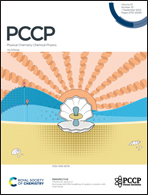Lithium isotope tracing in silicon-based electrodes using solid-state MAS NMR: a powerful comprehensive tool for the characterization of lithium batteries†
Abstract
The introduction of lithiated components with different 7Li/6Li isotopic ratios, also called isotopic tracing, can give access to better understanding of lithium transport and lithiation processes in lithium-ion batteries. In this work, we propose a simple methodology based on high-resolution solid-state NMR for the determination of the 7Li/6Li ratio in silicon electrodes following different strategies of isotopic tracing. The 6Li and 7Li MAS NMR experiments allow obtaining resolved spectra whose spectral components can be assigned to different moieties of the materials. In order to measure the ratio of the 6Li/7Li NMR integrals, a silicon electrode with a natural 7Li/6Li isotope abundance was used as a reference. This calibration can then be used to determine the 7Li/6Li ratio of any similar samples. This method was applied to study the phenomena occurring at the interface between a silicon electrode and a labeled electrolyte, which is an essential step for isotopic tracing experiments in systems after the formation of the solid electrolyte interphase (SEI). Beyond the isotopic exchanges between the SEI and the electrolyte already observed in the literature, our results show that isotopic exchanges also involve Li–Si alloys in the electrode bulk. Within a 52-hour contact, the electrolyte labeling disappeared: isotopic concentrations of the electrolyte and electrode become practically homogenized. However, at the electrode level, different silicides are characterized by rather different isotopic enrichment. In the present work, ToF SIMS and liquid state NMR were also used to cross-check and discuss the solid-state NMR method we have proposed.



 Please wait while we load your content...
Please wait while we load your content...